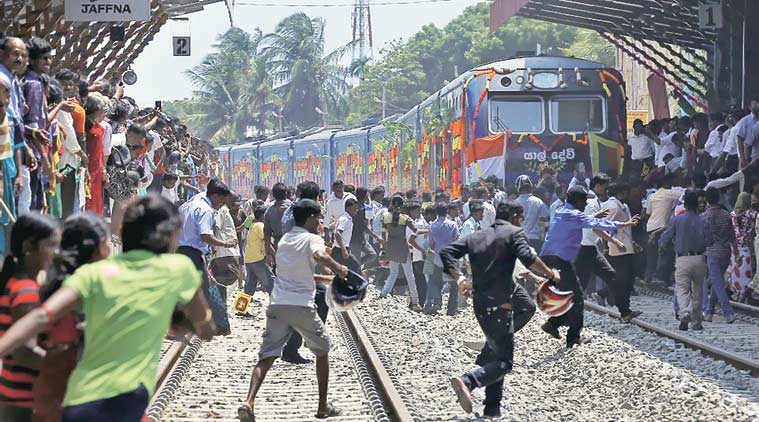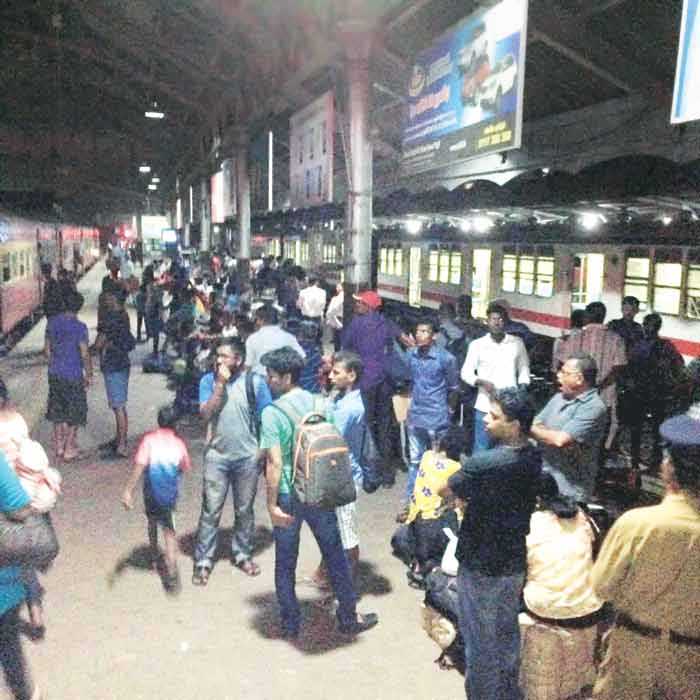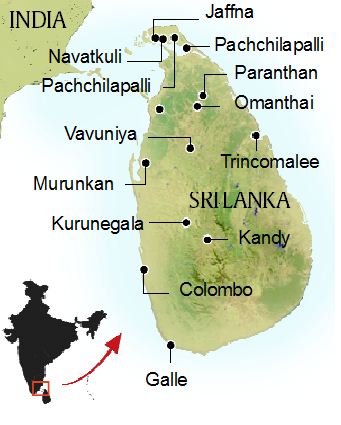Stay updated with the latest - Click here to follow us on Instagram
Sunday Story: The train returns to Jaffna
From the relaunch of train services and a second thumbs-down to Mahinda Rajapaksa to a newfound ambition to play national cricket, the city is putting behind its war bruises.
 The Jaffna-Colombo Intercity Express, which was taken off the tracks during the war years, whizzes past the A9 highway, once the battlefield between the LTTE and the Sri Lankan army. (Source: AP)
The Jaffna-Colombo Intercity Express, which was taken off the tracks during the war years, whizzes past the A9 highway, once the battlefield between the LTTE and the Sri Lankan army. (Source: AP)It used to be known as the Highway of Blood. The Liberation Tigers of Tamil Eelam and the Sri Lankan army fought bloody battles on it for control of Vanni, Sri Lanka’s northern mainland. Thousands of soldiers and LTTE cadres would die as they pushed each other up and down this road, the A9, once the only lifeline between the Tamil North and the Sinhalese South.
From the picture windows in the sleek blue Chinese coaches of the airconditioned Jaffna-Colombo Intercity Express, the A9 is a constant travelling companion, running parallel to the Indian IRCON-built rail track. But now, from the carpeted surface and the neat white lines demarcating the two-lane highway, you could hardly guess its blood-soaked history.
Or of the places the train is whizzing past. Less than 20 years ago, Elephant Pass, Murunkan, Pallai were all places known by the number of days the two sides fought to establish control over them.
[related-post]
But on a recent August morning, the smallness of these places was only too painfully apparent. The train doesn’t stop at them. Even the names on the deserted platforms are a blur.
If only the road could speak, it would tell stories of deadly LTTE ambushes, of mass funerals, of displaced Tamil families living in temporary homes between battles.
You should have been there, the road would tell the train.
It would also tell the train how badly it had been missed for all those 24 years, from the time the last Colombo-Jaffna service went up the tracks and could not return.
 Many passengers took the train to Jaffna on August 17 to cast their vote in the parliamentary election. (Source: Express Photo by Nirupama Subramanian)
Many passengers took the train to Jaffna on August 17 to cast their vote in the parliamentary election. (Source: Express Photo by Nirupama Subramanian)Jaffna Tamils know a thing or two about travelling.
But there used to be a time when, for the Jaffna Tamil, travelling was not always fleeing or escaping. Back then, before the “prachinaikal (the troubles)”, travel was the Colombo-Jaffna train journey, going home on the Yarl Devi, packing a meal of string hoppers and sambol, or puttu and hot Jaffna drumstick curry for the way.
It is August 17, 25 years almost to the day since the Jaffna station was bombed during the war. The burnt-out shell has been replaced by a spanking new, squeaky clean station. There are blue seats to sit on, and a waiting lounge for first-class passengers.
There are four daily trains now between Jaffna and Colombo and they are all booked in advance, especially during weekends.
August 17 is also voting day in the parliamentary election. Less than eight months before, the Tamils in the North had contributed in a big way to voting out Mahinda Rajapaksa as president. Clearly, people in Jaffna believe there is much more to be done than just restarting the train service.
Many of the passengers waiting at the platform for the 1.45 pm Intercity Express to Colombo would have cast their vote before catching the train. The train pulls into the station on time, at 1.38 pm. It will leave in exactly seven minutes.
Among the passengers are Rajadurai Nagularajah and his wife Vasuki, both expatriates living in Toronto. They do not have a vote in Sri Lanka. In Jaffna, they were visiting Nagularajah’s father, now 96. He, incidentally, used to be the driver on the Yarl Devi long ago, and Nagularajah remembers travelling with him in the engine.
“He did not know the train is back running. He insisted on coming all the way from our ancestral home in Point Pedro (25 km away) to see me off,” says Nagularajah.
The 55-year-old joined the Merchant Navy in 1979, when the troubles in Jaffna were just beginning. “I don’t know anything about those things,” he says. Nagularajah returned in 1987 only to get married.
“On the day of our wedding, we could hear firing,” Vasuki says. “On that day, we knew we had to leave Sri Lanka for good.”
Their two daughters, Nivetha and Varshini, are now 23 and 20. The elder has qualified as an engineer and the younger one is studying to be a lawyer. Vasuki recalls a time when she returned with one of her daughters to Jaffna, and slept out in the open, as she waited for a boat to cross from the mainland to Jaffna peninsula over the Kilali lagoon.
A doctor, who would not tell his name, points out that the train is much cheaper than the bus, and much safer too. At Rs 1,500, the first-class AC fare is almost the same as the first-class train fare, but a third-class ticket is only Rs 300.
The doctor came to Jaffna to cast his vote for the parliamentary election and is on his way back to Colombo.
Two girls returning to their university in Chittagong, Bangladesh, also talk about how much easier it is for them to visit home during the holidays now.
Earlier, on the night mail service up to Jaffna, a 27-year-old woman working as a consultant for the Railways gets in carrying a rucksack. She is going home to vote. As the train starts, she begins talking, first about her job at the other end of Sri Lanka, then dwelling on the irony of how some trains on this Indian-made track were Chinese and how cleverly Sri Lanka had played its hand in the matter, how the extremely bumpy ride up to Vavuniya would smooth out once the Indian-made stretch of the tracks began from Omanthai, and then about her family and how they were displaced during the war.
She remembers trekking with her family from Jaffna to Kilinochchi as an eight-year-old in 1995. Her mother took her and another sister to government-controlled Vavuniya, but a third sister had to stay back because the LTTE, then looking to recruit teenagers, would not allow her to leave.
Her father went with his ageing mother to Trincomalee. The family reunited when they returned to Jaffna a year later.
The lights and fans in the third-class coach have been switched off by now, and it is close to midnight. But the young woman wants to continue the conversation.
“When I think of how many people were killed, I feel like taking a gun and shooting the people who were the cause of such misery,” she adds quietly, her voice just audible over the rattle of the train.
Then she bends down over the rucksack on her lap, lays her head on it, and closes her eyes, trying to sleep.
On August 18, the results come out. Rajapaksa is again defeated. It is also clear that Jaffna voted to keep out extreme Tamil nationalist elements.
ON TRACK
* The first train to Jaffna arrived in 1905 under the British. The Colombo-Jaffna line was and remains the longest rail line in the country.
* Mahatma Gandhi took a train to Jaffna in November 1927, during his first and last trip to Sri Lanka, then known as Ceylon.
* Yarl Devi Express, meaning the Queen of Jaffna, started running in 1956, covering the 339-km distance from Colombo to Jaffna in six hours.
* On January 19, 1985, Tamil militants bombed the Yarl Devi at Kokavil, destroying the train tracks and killing 22 soldiers and 11 civilians.
* In 1990, the rail link to Jaffna was shut down. Trains would stop at Vavuniya, 140 km short of the city.
* After the war ended, the line between Vavuniya and Omanthai was rebuilt by the Lankan military.
* India’s IRCON helped restore the 96-km section from Omanthai to Pallai, 40 km from Jaffna. The project took four years.
* India gave $800 million for restoring the tracks; around 4,000 people from India worked on it.
* The first train to Jaffna in 24 years reached on October 13, 2014.
- 01
- 02
- 03
- 04
- 05
































